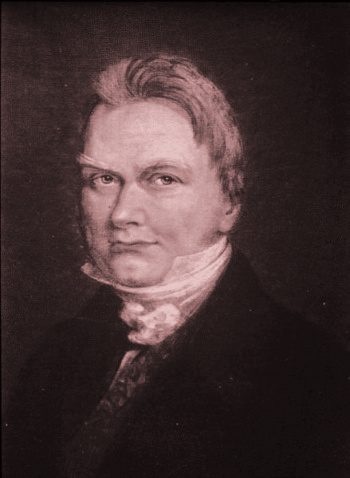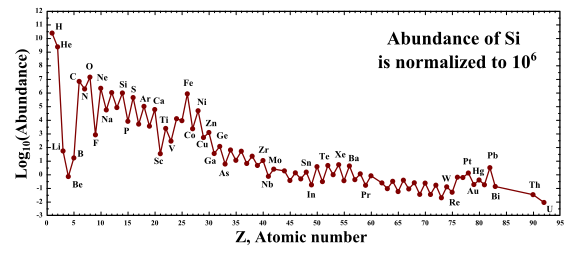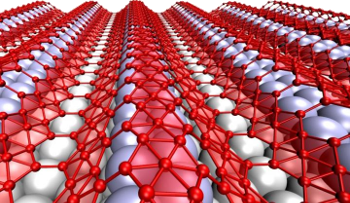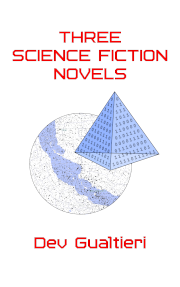| | Fluorine (F) | Tungsten (W) |
All of these symbols seem appropriate to English speakers, except those for potassium K and tungsten W. Potassium's K comes from the Latin word for alkali, as derived from the Arabic. The name, "kallium," for potassium followed from a recommendation by the prominent Swedish chemist, Jacob Berzelius (1779-1848), discoverer of silicon, selenium, thorium, and cerium, so K became potassium's symbol.

Jacob Berzelius (1779-1848)
Berzelius, who is considered to be one of the first modern chemists, is best known for his experiments on the stoichiometry of chemical compounds, and for the determination of atomic weights using electrochemical cells.
He wrote the formulae of chemical compounds using the letter symbols we have today.
(Wikimedia Commons image, modified for artistic effect.)
The chemical symbol for tungsten has had an interesting history also. Tungsten is found in the mineral, wolframite ((Fe,Mn)WO4), which gets its name from the German, "wolf rahm," or wolf soot. The mineral gets this name from its ability to "wolf down" significant quantities of tin, a fact noted by the early mineralologist and metallurgist, Georgius Agricola. For this reason, tungsten is known as "wolfram" in several European languages, and thus the W symbol.
Boron, another of the single-letter elements, has the low atomic number of five, and low atomic numbers are usually indicative of high abundance in both the Solar System and in Earth's crust (see figure). Boron, however, exists at only 10 parts-per-million in Earth's crust. The low boron abundance arises from the fact that it's not created by fusion reactions in stars, but only by cosmic ray induced fission of elements created in the Big Bang.

Abundance of the elements in the Solar System. (Modified Wikimedia Commons image.)
There's still plenty of boron available to be useful. Borax, sodium borate (Na2B4O7·10H2O), is useful as a detergent, an anti-fungal agent, an insecticide, a fire retardant, and as a flux in metallurgy. Older readers might remember television commercials for 20 Mule Team Borax that got its name from its early method of transport from Death Valley deposits. Boric oxide (B2O3) is used to make borosilicate glass, and I used it as a flux component in liquid phase epitaxy. Boron is used to make powerful rare earth magnets, such as Nd2Fe14B, and as a dopant for semiconductors.
Boron is nestled in the periodic table near carbon, silicon and germanium, and it was found to function as a semiconductor, although not as glamorous a semiconductor as it's neighboring elements.[1] Scientists from Rice University (Houston, Texas), Argonne National Laboratory (Argonne, Illinois), and Northwestern University (Evanston, Illinois) have now found that single layers of boron similar to graphene can be grown on silver surfaces.[2-4] This material, named borophene, grows with corrugations to adapt to the atomic surface of silver. These corrugations may allow borophene's use in bendable electronics.

A layer of borophene, a two-dimensional form of boron, on a silver surface. Boron has three bonding electrons, while carbon has four, thus the unusual structure.
(Zhuhua Zhang/Rice University image.)
The discovery of graphene was so important that only six years elapsed before the award of a Nobel Prize to its discovers. Graphene technology has advanced quickly beyond the exfoliated flecks of graphene stuck to cellophane tape in the first experiments, and I've reviewed graphene in quite a few articles (Graphene-Copper Heat Sinks, March 26, 2014, Graphene Production, May 26, 2014, and Graphene from Nickel, June 11, 2014). While graphene has useful electronic properties, it's too stiff for flexible electronics that need to stretch, compress, and twist.[4]
theoretical physicist Boris Yakobson, and his Rice University colleague, Zhuhua Zhang, a postdoctoral researcher and first author of the paper on this research, did first-principles calculations and computer simulations that revealed that periodic nanoscale one-dimensional undulations are energetically favored over the planar form for borophene on the (111) face of silver, Ag(111).[2,4] Structurally, wavy borophene is a triangular lattice with periodic arrays of hexagonal vacancies.[4]
An experimental team from Argonne National Laboratory and Northwestern University was able to create small patches of the material.[4] Atomic-scale, ultrahigh vacuum, scanning-tunneling-microscopy revealed wavy borophene.[4] The structure of the borophene on Ag(111) agreed with theory.[2] Wavy borophene will only form in this manner, and growth on other substrates results in a flat, inflexible layer.[4] The wavy nature of the borophene, however, is retained when the layer is transferred to another substrate.[4] Says Zhang,
"This wavy conformation so far seems unique due to the exceptional structural flexibility and particular interactions of borophene with silver, and may be initially triggered by a slight compression in the layer when a bit too many boron atoms get onto the surface."[4]
This research was funded by the Department of Energy, the Office of Naval Research, and the National Science Foundation.[4]
References:
- Wolfgang Dietz and Hermann Helmberge, "Boron Semiconductor Devices," in "Boron: Volume 2: Preparation, Properties, and Applications," Springer (Boston, 1965), pp. 301-316.
- Zhuhua Zhang, Andrew J. Mannix, Zhili Hu, Brian Kiraly, Nathan P. Guisinger, Mark C. Hersam, and Boris I. Yakobson, "Substrate-Induced Nanoscale Undulations of Borophene on Silver," Nano Lett., Article ASAP, September 22, 2016, DOI: 10.1021/acs.nanolett.6b03349.
- Supplemental Information for ref. 2 (PDF File).
- Mike Williams, "Long may you wave, borophene, Rice University Press Release, October 4, 2016.
Permanent Link to this article
Linked Keywords: Chemical element; symbol; hydrogen; sulfur; boron; potassium; carbon; vanadium; nitrogen; yttrium; oxygen; iodine; fluorine; tungsten; phosphorus; uranium; English language; Latin; alkali; Arabic; Sweden; Swedish; chemist; Jacob Berzelius (1779-1848); silicon; selenium; thorium; cerium; experiment; stoichiometry; chemical compound; atomic weight; electrochemical cell; empirical formula; Wikimedia Commons; history; mineral; wolframite; German language; wolf; soot; wolf down; tin; mineralogy; mineralologist; metallurgy; metallurgist; Georgius Agricola; European language; atomic number; abundances of the elements; Solar System; Earth's crust; parts-per-million; nuclear fusion; nuclear reaction; star; cosmic ray spallation; cosmic ray induced fission; Big Bang; Borax; detergent; anti-fungal agent; insecticide; fire retardant; flux; television commercial; 20 Mule Team Borax; transport; Death Valley; ore; deposit; boron trioxide; boric oxide; borosilicate glass; liquid phase epitaxy; rare earth magnet; dopant; semiconductor; nestle; periodic table; carbon; silicon; germanium; scientist; Rice University (Houston, Texas); Argonne National Laboratory (Argonne, Illinois); Northwestern University (Evanston, Illinois); graphene; silver; borophene; crystal growth; corrugation; atom; atomic; flexible electronics; bendable electronics; two-dimensional space; allotrope; molecular orbital; bonding electron; Nobel Prize in Physics; exfoliated graphite nanoplatelets; exfoliated flecks of graphene; cellophane; compression; compress; twist; theoretical physics; theoretical physicist; Boris Yakobson; Zhuhua Zhang; postdoctoral research; author; scientific literature; paper; first-principles; calculation; computer simulation; periodic function; nanoscopic scale; nanoscale; one-dimensional; Gibbs free energy; energetically favored; planar; Miller index; (111) face; triangular lattice; hexagonal vacancy; experimental; material; ultrahigh vacuum; scanning tunneling microscope; scanning-tunneling-microscopy; theory; substrate; conformation; funding of science; Department of Energy; Office of Naval Research; National Science Foundation.
 RSS Feed
RSS Feed
Google Search
Latest Books by Dev Gualtieri
Previews Available
at Tikalon Press

STEM-themed novel for middle-school students



Mathematics-themed novel for middle-school students



Complete texts of LGM, Mother Wode, and The Alchemists of Mars

Other Books

Blog Article Directory on a Single Page
Recent Articles
- 100 Years of IBM, May 6, 2024
- Cicada Apocalypse, April 29, 2024
- Critical Materials, April 22, 2024
- Eclipse 2024, April 15, 2024
- Reverse Sprinkler, April 8, 2024
- T Coronae Borealis, April 1, 2024
- Coffee and Tea, March 25, 2024
- Arno Penzias (1933-2024), March 18, 2024
- Wave-Particle Duality, March 11, 2024
- Offshore Wind, March 4, 2024
- High Entropy Ceramics, February 26, 2024
- Methane Emissions, February 19, 2024
- Thales, Heron, and Experimental Mathematics, February 12, 2024
- Mica, February 5, 2024
- Disk Packing, January 29, 2024
- Is eπ > πe?, January 22, 2024
- Brownian Motion Energy Harvesting, January 15, 2024
- Coin Flip, January 8, 2024
- Holidays 2023, December 18, 2023
- Fast Radio Bursts, December 11, 2023
- Adhesives, December 4, 2023
- MOND and Planet Nine, November 27, 2023
- Earthquake Light, November 20, 2023
- Antimatter Gravitation, November 13, 2023
- Koch Snowflake, November 6, 2023

Deep Archive
Deep Archive 2006-2008
